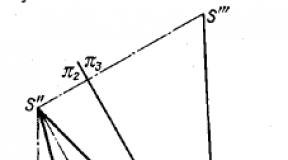Genetic diseases. Marfan syndrome in children: symptoms, signs, treatment, causes Marfan syndrome causes
- a disease of connective tissues, in which the synthesis of fibrillin protein, an important component of many body structures, is disrupted. It occurs with a frequency of 1 case per 10-20 thousand people, while race and gender do not matter. In 75% of cases, Marfan syndrome is inherited from parents, and in the rest it is the result of mutations.
Lifespan
In the absence of treatment, patients with Marfan syndrome rarely live more than 30-40 years, however, with the timely detection of the disease and the implementation of the doctor's recommendations, life can be extended. Today, people with Marfan syndrome can live to an advanced age, lead a moderately active lifestyle. A common cause of death in patients is aortic rupture, which occurs during intense physical exertion.
This is the greatest danger of the disease - if it is not diagnosed on time, a person considers himself absolutely healthy and can expose himself to overexertion while running sprints, swimming, cycling, or doing heavy physical labor. Because people with Marfan syndrome are often tall, long-limbed, and have large arms, they are often encouraged to try sports, which increases their risk of mortality.
Symptoms of Marfan Syndrome
Patients with Marfan syndrome have a specific appearance, which simplifies the diagnosis of the disease. Usually they are tall, elongated limbs, while the lower torso is longer than the upper, and the span of the arms is greater than the height. Asthenic physique is combined with insufficient body weight, which is often less than 50 kg. Elongated fingers (arachnodactyly or "spider fingers") make it possible to diagnose diseases by the symptom of the wrist and the symptom of the thumb (when the finger looks out at the whole phalanx from the hand, even if it is clenched into a fist).
People with Marfan syndrome are distinguished by characteristic facial features, which gives it a “bird-like” expression common to all patients in this group. The eyes are deep-set, the skull is elongated, the teeth are crowded due to the small size of the jaw, the Gothic "sky". The nose seems large, the ears are rather large and set low. In one person, it is rare to find all these manifestations; most often, among the external signs, only high growth and elongated fingers are noted.
Due to the weakness of the connective tissues, patients with Marfan syndrome may experience striae (stretch marks on the skin), which are not associated with sudden changes in weight or hormonal disorders. These symptoms usually appear in the lower third of the back, lumbar and shoulder area.
Another common symptom is hernias, which occur spontaneously or after surgery, developing due to the weakness of the connective tissues. Even after surgical treatment, a hernia in a patient with Marfan syndrome may reappear.
A common symptom on the part of the organs of vision is a subluxation of the lens, which develops due to pathologies of the connective tissue ligaments, as well as myopia. Patients may experience secondary glaucoma and other eye diseases. Loss of vision, along with cardiovascular pathologies, is the main danger of Marfan's syndrome.
On the part of the musculoskeletal system, spinal curvature of the type of lordosis, kyphosis and scoliosis, indentation and deformity of the chest, hypermobility of the joints, muscle hypotension and flat feet are often observed.
On the part of the respiratory system, pathologies often appear associated with a curvature of the chest, as a result of which it compresses the lungs. The risk of spontaneous pneumothorax is increased, which should be taken into account when playing sports and physical activity.
From the side of the cardiovascular system, dissection of the walls of the aorta, pathology of the heart valves are observed.
As for the intellectual development of patients with Marfan syndrome, it does not fall below the limits of the norm, and in some cases can significantly exceed it. So, with an average IQ of 85 units in patients with Marfan syndrome, IQ can be more than 115, which is a very high indicator and is found in gifted people. It is believed that this is due to the high level of adrenaline in people with this disease, because of which they are ambitious, strive to be better than others in many respects and absorb information faster.
Mental processes in Marfan's syndrome proceed in a peculiar way - children with this disease can be hyperactive, nervous and irritable, have high self-esteem, react painfully to the slightest stimuli, often cry. However, all these manifestations do not unequivocally indicate the presence of a disease, but may be associated with the characteristics of temperament and the course of mental processes.
Symptoms associated with visual impairment appear quite early - lens subluxation is found even in one-year-old children or is diagnosed at 6-7 years before entering school. Other vision pathologies - retinal detachment and cataracts - appear in patients aged 15 to 40 years.
Marfan syndrome is manifested by a feeling of severe fatigue and exhaustion after physical exertion, muscle pain, weakness and hypotension - all this indicates a dysfunction of mitochondria, which provide energy processes in cells.

Marfan syndrome is a genetic disease with autosomal dominant heritability, the cause of its development are mutations in the FBN1 gene. This gene is responsible for the production of fibrillin-1, an important structural protein that is part of the ligaments and elastic vessels. With violations in the structure of this protein, connective tissue structures become more extensible, while losing resistance to deformation. The most dangerous consequences of such changes are manifested by the organs of vision and the cardiovascular system. Fibrillin-1 is necessary for the normal functioning of the zinn ligament that attaches the lens of the eye to the ciliary body. Therefore, if its synthesis is disturbed, which occurs in patients with Marfan's syndrome, the zonium ligament is weakened, which at the first stages is manifested by myopia in the patient, subluxation of the lens, but in the future can lead to secondary glaucoma, partial or complete loss of vision.
Other functions of fibrillin in the body are the formation of an extracellular matrix, which ensures the integrity of connective tissues and the normal functioning of cell growth factors.
The aorta belongs to the vessels of the elastic type and contains many elastic ligaments, on which its resistance to stress depends. In case of violation of their function, an expansion of the aorta occurs, stratification of its walls. This situation endangers the life of the patient, can provoke sudden death due to rupture of the aorta during intense physical exertion. Expansion of the aorta is dangerous for women during pregnancy, especially in the third trimester, as well as during childbirth and a few months after them.
Other common heart conditions associated with Marfan syndrome include mitral valve disease, which necessitates surgical treatment.
Is Marfan syndrome inherited?
Marfan syndrome is a genetic disease that in 75% of cases is inherited by family type, and the remaining 25% of occurrence is the result of a primary gene mutation. In families where the father is older than 35, the risk of having a child with Marfan syndrome increases.
The development of symptoms begins already in the period of perinatal development - connective tissue fibers lose strength in the process of formation, which begins changes in elastic vessels, the musculoskeletal system, eye cords, hard palate, and heart valves. The progression of the disease continues in the postnatal period, and lasts the entire life of the patient.
Diagnosis of Marfan's syndrome
Marfan's syndrome is diagnosed on the basis of physical examination data, family history, examination by a cardiologist and ophthalmologist, chest x-ray.
An important role in the diagnosis is played by the following criteria:
The presence of defects in the chest that require surgical intervention;
The presence of pathological changes in tissues and organs of the visual, cardiovascular system, characteristic of Marfan's syndrome;
Ectopic lens;
The upper part of the body is much shorter than the lower part, their ratio is greater than 0.86;
The arm span is greater than the height (their ratio is greater than 1.05);
With Marfan's syndrome, the excretion of glucosamines through the kidneys increases several times, which is also used in diagnosis.
ECG and echocardiography can detect cardiac abnormalities. To detect pathologies from the respiratory system, an examination of external respiration is carried out. Patients with Marfan's syndrome often present with pulmonary distention, hypercapnia, uneven distribution of air throughout the lungs, and a variety of respiratory failures.
DNA studies (direct automatic sequencing) make it possible to determine the presence of mutations in the FBN1 gene and identify them.

Treatment of Marfan's syndrome is symptomatic and is aimed at reducing the negative manifestations of the disease in the cardiovascular, visual and other systems.
In order to prevent complications, patients are advised to avoid sports associated with sharp throws and jerks, such as basketball, sprinting, contact sports, during which bodily injury is possible. Nevertheless, one should not give up sports at all, such activities that cause a sharp change in heart rate and heart rate fall into the risk group. If you control your heart rate during sports and do not go beyond safe indicators, then such activity is not contraindicated.
From an early age, it is recommended to take drugs that reduce the load on the aorta, such as beta-blockers. As part of complex treatment, children with Marfan syndrome are prescribed vitamin complexes, antioxidants and energy-tropic drugs in courses lasting a month several times a year.
These include:
-
Limontar course of ten days at the rate of 5 mg per 1 kg of weight;
Dimephosphon.
Tocopherol, ascorbic acid, B vitamins;
Riboxin tablets;
Coenzyme Q10;
Of the nootropic drugs, piracetam is prescribed at a dose of 400 mg twice a day for a course of two months, repeated 3-4 times a year.
Surgical intervention for cardiac symptoms of the disease is required if the patient's aortic root reaches 5 cm or more.
Throughout his life, a patient with Marfan syndrome must constantly undergo examinations by specialists in various fields - ophthalmologists, cardiologists, orthopedists and geneticists, since the disease manifests itself differently in each individual case, provoking dysfunction of various organs and systems.
In addition, it is necessary to sanitize the foci of infection in the oral cavity with the use of antibiotics, since patients with Marfan's syndrome have a weakened immune system. Antibiotic therapy for prevention is used even for minor surgical interventions to reduce the likelihood of developing infective endocarditis.
Surgical correction is subject not only to heart pathologies, dissection of the aortic walls and valve lesions, but also diseases of the internal organs and skeleton that occur during the progression of Marfan's syndrome.
Beta-blockers are used not only to reduce the load on the cardiovascular system, but also effectively remove the negative manifestations of arterial hypertension and that are characteristic of this disease.
Education: Moscow Medical Institute. I. M. Sechenov, specialty - "Medicine" in 1991, in 1993 "Occupational diseases", in 1996 "Therapy".
Etiology and occurrence of Marfan syndrome. (MIM No. 154700) is a pan-ethnic autosomal dominant connective tissue disease caused by mutations in the fibrillin 1 gene (FBN1, MIM No. 134797).
Marfan syndrome has an incidence of about 1 in 10,000. Approximately 25-35% of patients have a new mutation. The mutations that cause Marfan syndrome are scattered throughout the gene, and each mutation is usually unique within a family.
The pathogenesis of Marfan's syndrome
FBN1 gene encodes fibrillin 1, an extracellular matrix glycoprotein with a wide distribution. Fibrillin 1 polymerizes to form microfibrils in both elastic and non-elastic tissues such as the aortic wall, ciliary girdles, and skin.
Mutations affect synthesis, processing, secretion, polymerization or stability of fibrillin 1. Studies of the accumulation and expression of fibrillin 1 in cell culture suggested a dominant negative pathogenesis, i.e. the synthesis of mutant fibrillin 1 inhibits the formation of normal microfibrils by normal fibrillin 1 or stimulates the proteolysis of inappropriate extracellular microfibrils.
Recent studies in mice models of Marfan syndrome indicate that half the amount of normal fibrillin 1 is not enough to efficiently assemble microfibrils. Thus, haploinsufficiency may also contribute to the pathogenesis of the disease.
Except Marfan syndrome, mutations in the FBN1 gene can cause other syndromes, including neonatal Marfan syndrome, isolated skeletal symptoms, autosomal dominant lens ectopia, and the MASS phenotype (marfanoid symptoms including mitral valve prolapse or myopia, borderline and non-progressive aortic dilatation, and nonspecific skeletal and skin changes ).
All in all, phenotypes are quite similar within families, although the severity of phenotypic manifestations can vary considerably. To date, the exact relationship between genotype and phenotype has not been determined. Intrafamilial and interfamilial variability suggests that environmental and epigenetic factors play an important role in determining the phenotype.
Recent studies in mouse models show that fibrillin 1 is not just a structural protein, and that it is not just the result of structural tissue weakness. Moreover, fibrillin 1 microfibrils normally bind and reduce the concentration and activity of growth factors of the TGFb superfamily.
The loss fibrillin 1 increases free TGFb signals significantly contributing to disease, as TGFb antagonists reverse the pulmonary and valvular changes seen in fibrillin-1 deficient mice.
Phenotype and development of Marfan syndrome
Marfan syndrome- a multisystem disease with skeletal, ocular, cardiovascular, pulmonary, skin and other abnormalities. Skeletal abnormalities include very tall stature (armspan-to-height ratio >1.05; upper-to-lower segment ratio<0,85 у взрослых), арахнодактилию, аномалии грудины, сколиоз, разболтанность суставов, готическое нёбо.
anomalies eye include lens subluxation, flattening of the cornea, elongation of the eyeball, and iris hypoplasia. Cardiovascular abnormalities include mitral valve prolapse, aortic regurgitation, and dilatation and dissecting aneurysm of the ascending aorta. Pulmonary anomalies include spontaneous pneumothorax and expansion of the terminal vesicles. Skin abnormalities include atrophic grooves and recurrent hernias. Anomalies of the dura mater include bulging of the membrane in the sacro-lumbar region.
Majority signs of Marfan syndrome appear with age. Skeletal anomalies such as sternum anomalies and scoliosis worsen with bone growth. Lens subluxation is often present in early childhood but may also develop in adolescence.
With increased frequency Marfan's syndrome retinal detachment, glaucoma and cataracts occur. Cardiovascular complications are found at any age and develop throughout life.
The main causes of premature of death patients with Marfan's syndrome - heart failure due to valvular regurgitation and aneurysm and rupture of the aorta. However, with improved surgical and medical care for aortic aneurysms, survival has improved. From 1972 to 1993, the expected survival age for 50% of patients rose from 49 to 74 years for women and from 41 to 70 years for men.
Peculiarities phenotypic manifestations of Marfan syndrome:
Age of onset: early childhood
disproportionately tall
Skeletal anomalies
Ectopia (subluxation) of the lens
Mitral valve prolapse
Aneurysm and rupture of the aorta
Spontaneous pneumothorax
Hernia of the meninges in the lumbosacral region

Treatment of Marfan's syndrome
Marfan syndrome- clinical diagnosis, determined by the presence of specific symptoms. Confirmation of Marfan syndrome by identification of mutations in the FBN1 gene is currently practically impractical, since extreme allelic heterogeneity makes the identification of a causal mutation in each family extremely laborious, and also because of an insufficiently reliable correlation between genotype and phenotype. Mutation analysis lacks sensitivity or specificity for Marfan syndrome, limiting its clinical utility.
For Marfan syndrome no effective treatment available; consequently, care is focused on prevention of complications and symptomatic treatment. Eye care includes regular check-ups, myopia correction, and often lens replacement. Orthopedic care consists of restorative treatment or surgical correction of scoliosis. Help with anomalies of the sternum is mainly cosmetic.
Physiotherapy can compensate for joint instability. Cardiovascular problems are solved by a combination of therapeutic and surgical measures. Therapeutic efforts are aimed at preventing or slowing down the development of aortic root dilation by reducing cardiac parameters, lowering blood pressure and ventricular ejection effort with beta-blockers, limiting participation in contact sports, competitive sports, and isometric exercises.
Preventive replacement root aortic valve is indicated when aortic dilatation or aortic regurgitation becomes severe enough. Most patients are currently undergoing supravalvular aortic root replacement, which does not require ongoing anticoagulation.
Hemodynamic changes associated with pregnancy may lead to progressive aortic dilation or dissection. Aortic dissection is thought to be secondary to hormonal changes, increased blood volume, and cardiac output associated with pregnancy and childbirth. Current research suggests that the risk of pregnancy is too great if the aortic root is more than 4 cm wide. Women may choose to have a supravalvular aortic replacement before pregnancy.
Risks of Inheriting Marfan Syndrome
Patients with Marfan syndrome have a 50% risk of having a child with Marfan syndrome. In families that transmit Marfan syndrome, family members at risk can be identified either by finding the mutation (in the rare cases where it is known) or by linkage analysis if markers closely linked to the FBN1 locus have an obvious association with the disease in the family of the proband. Prenatal diagnosis is available only for families in which linkage studies are possible or a mutation in the FBN1 gene is known.
An example of Marfan's syndrome. D.L., a healthy 16-year-old high school student, basketball star, is referred to a genetics clinic for examination for Marfan's syndrome. Physique D.L. similar to his father's physique. D.L.'s father, a tall, slender man, died while jogging in the morning; other family members had no cases of skeletal anomalies, sudden death, decreased vision, or congenital anomalies.
In recent years, there has been a significant increase in hereditary diseases with damage to the connective tissue. Some experts believe that the reason for this phenomenon lies in the accumulation of new genetic changes (mutations) in the process of human evolution, which are caused by internal and external environmental factors. Others believe that, in fact, diagnostic capabilities have simply increased due to the improvement of medical genetic knowledge, which makes it possible to recognize a genetic pathology and make a correct diagnosis.
A large group of hereditary diseases is the defeat of the connective tissue. Since it is an integral part of all organs and systems in the body, such pathologies are characterized by many disorders and clinical symptoms. One of the most well-known genetic diseases with connective tissue damage is Marfan's syndrome.
Such a pathology is characterized by a large variability of symptoms (from latent forms to life-incompatible variants of the course) and most often includes lesions of the cardiovascular system, eyes, central nervous system and musculoskeletal system.
The disease is quite rare - 1 case per 10,000 people. But if we turn to the statistics of European countries, then the frequency is much higher - 1-3 cases per 5000 people, which is associated with the greater availability of specific diagnostics of latent forms of pathology.

Famous people also suffered from Marfan syndrome
Causes and genetics of pathology
For the first time, the disease was described in detail in 1896 by the French pediatrician A. Marfan, after whom the pathology was named. He observed a 5-year-old girl of asthenic constitution with disproportionately long limbs and congenital arachnodactyly (long fingers). By the mid-20s of the last century, there were already many similar described clinical cases in children and adults. The American geneticist McKusick conducted a detailed study of chromosome mutations and discovered a new group of hereditary connective tissue diseases, where Marfan's syndrome was attributed.
According to the etiology, Marfan's syndrome is a genetic disease with an autosomal dominant type of inheritance, with varying degrees of expressiveness (clinical manifestations of genetic changes). Approximately 85% of cases of the disease are hereditary, that is, inherited from parents. The remaining cases are new, that is, they arise due to new spontaneous mutations, and are not inherited.
The immediate cause of the pathology in 95% of cases is a mutation in the gene that encodes the structure of fibrillin-1 and / or fibrillin-2. The mutation of the FBN1 and FBN2 genes is localized on chromosomes 15 and 3.

Marfan syndrome is inherited in an autosomal dominant manner
Fibrillin is the basis of the elastic fibers of the connective tissue of a glycoprotein nature. It forms the framework of the intercellular substance, vascular walls, cartilage, the lens of the eye and many other organs and tissues. In the case of the presence of the described mutation in a patient, the connective tissue is characterized by an increased ability to stretch, becomes less durable and resistant to mechanical stress, which causes the clinical manifestations of the syndrome.
In about 5% of cases, the direct cause of Marfan's syndrome (atypical forms of pathology) is a point mutation of the gene that encodes the structure of the α2-chain of collagen of the first type.
Classification
According to the ICD-10, Marfan's syndrome is included in the class of congenital developmental defects and chromosomal pathologies, here the pathology can be found under the code Q87.4.
A detailed clinical classification of the disease does not exist today, but several forms of the disease are distinguished, depending on certain criteria.
Depending on the severity of symptoms:
- erased form - signs of pathology are not very pronounced and may go unnoticed throughout life, as a rule, changes concern no more than 2 organ systems;
- clinically pronounced form - the symptoms of the pathology are clearly visible and occur in more than 2 organ systems.

Appearance of a child with Marfan syndrome
Depending on the genetic factor:
- the familial form is diagnosed in cases where the disease is inherited;
- the sporadic form is defined when the pathology is due to a new spontaneous mutation in an individual and does not occur in his relatives.
Symptoms of Marfan Syndrome
Signs of Marfan syndrome are very diverse. Therefore, they are considered from the point of view of damage to individual organs and systems:
- musculoskeletal system;
- organs of vision;
- of cardio-vascular system;
- nervous system;
- respiratory system;
- skin and soft tissues;
- other organs and systems.
Musculoskeletal system
Pathological connective tissue causes the development of a number of specific phenotypic signs and skeletal deformities in patients with this pathology.

Characteristic appearance of patients with Marfan syndrome
As a rule, externally, patients with Marfan syndrome look quite specific. They are characterized by:
- asthenic physique;
- high growth;
- poor development of subcutaneous adipose tissue, which makes people look thin;
- very long upper and lower limbs with a relatively short torso;
- the skull is elongated (dolichocephalic);
- elongated fingers - arachnid (arachnodactyly);
- face narrow, elongated vertically;
- gothic upper sky;
- underdevelopment of the cheekbones;
- protruding lower jaw (prognathism);
- improper growth (crowding) of teeth and pathological bite;
- hypermobility of the joints, their “looseness;
- eyes deeply set in the skull.

An example of how to determine the presence of arachnodactyly characteristic of Marfan syndrome
As the child grows, various skeletal deformities may appear. Most often there are curvature of the spinal column. Patients are diagnosed with scoliosis, pathological kyphosis and lordosis, posture of the "straight back" type (smoothing of the physiological lumbar lordosis). There are also subluxations and dislocations in the cervical spine, approximately 20% of patients are diagnosed with lumbar spondylolisthesis.

Severe degree of arachnodactyly in Marfan syndrome with specific contractures of the fingers
Other skeletal deformities include:
- protrusion of the acetabulum of the hip joint of 2-3 degrees, which causes dysplastic coxarthrosis and disability in many patients, if arthroplasty is not performed;
- keeled and depressed chest deformity;
- flat feet (longitudinal and transverse).
SM patients are also characterized by osteopenia (decrease in bone mineral density) and frequent pathological bone fractures against its background, as well as a tendency to habitual dislocations, for example, of the shoulder.

Depressed chest deformity in a patient with Marfan syndrome and the result of its surgical correction
The cardiovascular system
Among the lesions of the cardiovascular system in SM, the most common are:
- mitral valve prolapse with or without regurgitation
- myxomatosis of the heart;
- dilated cardiomyopathy with the development of heart failure;
- aneurysms of the aorta and other vessels (cerebral, renal, etc.);
- expansion of the pulmonary artery and various parts of the aorta.
It is the cardiovascular pathological changes in SM that determine the prognosis and life expectancy of patients. Approximately 90% of all patients with this genetic pathology die at the age of 40-50 due to complications such as dissection and rupture of aneurysms of the aorta and other vessels, progressive heart failure due to dilatation of its chambers and changes in the valvular apparatus.
In the presence of SM, there may be congenital heart defects in children. The most common are coarctation of the aorta, stenosis (narrowing) of the pulmonary artery, defect of the interventricular and interatrial septum.
Also, such patients are prone to various cardiac arrhythmias, including life-threatening ones (atrial fibrillation, ventricular tachycardia and extrasystole), to infective endocarditis.

Aortic aneurysms and their rupture are the most common cause of death in patients with Marfan syndrome.
Organ of vision
Pathological changes in the eyes are very characteristic of this disease. Approximately 60-80% of patients are diagnosed with dislocation of the lens due to the weakness of its ligamentous apparatus, and even in infancy. Other characteristic features include:
- flattening of the cornea;
- an increase in the size of the eyeball in length;
- myopia or hypermetropia;
- violation of the process of accommodation due to underdevelopment of the ciliary muscle.
If the described lesions of the organ of vision are detected in a newborn child, one should think about a possible genetic pathology.

Dislocation of the lens is a typical sign of Marfan's syndrome
Nervous system
Due to the pathological structure of the vessel walls, patients with SM have an increased risk of hemorrhagic strokes, as well as cerebral hemorrhages in case of rupture of vascular aneurysms, subarachnoid bleeding.
Ectasia occurs among developmental anomalies. Most often, one has to deal with lumbosacral ectasia of the meninges (protrusion outside the spinal canal through a defect in the structure of the vertebrae). This is a large criterion for SM, which occurs in 40% of cases.
Some patients have deviations in intellectual development, but most people with SM are characterized by high IQs.
Organs of the respiratory system
In most cases, changes in the bronchopulmonary apparatus are diagnosed by chance. It is characterized by the development of bullae in the upper parts of the lungs, which can sometimes rupture with the development of spontaneous pneumothorax.
Also, due to deformities of the chest, patients are prone to the development of emphysema, frequent respiratory infections and respiratory failure.

Bullous emphysema may be the cause of spontaneous pneumothorax in patients with Marfan syndrome
Skin and soft tissue
There is an increased extensibility of the skin, which is combined with the development of atrophic striae. The latter appear spontaneously, they have nothing to do with weight fluctuations, pregnancy or hormonal disorders. Subcutaneous fat is poorly expressed in patients with Marfan syndrome. They often suffer from recurrent hernias of the anterior abdominal wall.
There are many other pathological symptoms of damage to other organs and tissues in SM. For example, prolapse of the kidneys (nephroptosis), prolapse of the bladder and uterus in women, varicose veins, chronic constipation, etc.

Diagnosis of Marfan's syndrome
Diagnosis of Marfan syndrome is mainly clinical. Be sure to take into account the anamnesis, including family history (the presence of similar problems in one of the relatives), data from an objective examination and examination. Also, many additional diagnostic procedures are carried out to identify the pathology of certain organs and systems. To do this, use ECG, ultrasound of the heart and blood vessels, chest X-ray, CT, MRI of internal organs, spine, brain, ophthalmoscopy and other studies of the organ of vision, aortography, angiography and many other techniques, depending on the clinical situation and symptoms of the disease.
There are generally accepted diagnostic criteria for Marfan's syndrome (large and small), which allow with a high degree of probability to make a correct, but preliminary diagnosis to the patient.

The final diagnosis of Marfan's syndrome is made only after the analysis of the genotype (DNA diagnostics) and the identification of a specific mutation in the gene responsible for the production of fibrillin using molecular genetic techniques.
Treatment of the disease
Unfortunately, today it is impossible to cure Marfan syndrome, as well as to influence its cause. Therapy is mainly aimed at improving the quality of life of a sick person, eliminating symptoms and preventing complications.
Treatment of Marfan syndrome should be comprehensive and may include both conservative and surgical techniques.
Patients should be observed by various doctors: a cardiologist, an ophthalmologist, an orthopedic traumatologist, a clinical geneticist, a neurologist, etc.

The treatment of Marfan syndrome should be handled by a whole team of specialists
In case of detection of certain cardiovascular problems, complex treatment is prescribed, medicines for the prevention of complications. Carry out drug correction of arrhythmias, heart rate, blood pressure. All patients are required to take beta-blockers if there are no contraindications to this group of drugs that have a protective effect against possible aortic dissection.
In case of pathology of the valvular apparatus of the heart, aneurysm of the aorta and other vessels, separation of their walls, an operation may be necessary. Surgery is also used to correct deformities of the musculoskeletal system.
In case of problems with the organ of vision, surgical interventions are also performed for ectopia of the lens, laser vision correction, glasses or contact lenses are selected.
In general, the selection of treatment methods and the range of drugs used are very individual. It depends entirely on the symptoms present and the severity of the disease in a particular patient.

The main goal in the treatment of patients with Marfan Syndrome is to prevent cardiovascular damage.
Forecast
Marfan's syndrome is characterized, as a rule, by a chronic progressive course. The life expectancy of patients under the condition of a full-fledged complex of therapeutic measures is on average 45 years. The main risk factors for premature death are complications that arise due to the pathology of the cardiovascular system.
Marfan syndrome and pregnancy
Patients with SM can have children, and healthy ones, but this is very dangerous for two reasons:
- A pregnant woman has a very high risk of lethal complications of SM from the cardiovascular system. Since when carrying a child, an increased load is created on the mother's body, and especially on the heart and blood vessels, there are very high chances for patients with Marfan's syndrome to get aneurysm rupture, its formation, aortic dissection and other deadly complications.
- The risk of passing this hereditary pathology to your child is 50%.
Is it possible to prevent the disease?
Unfortunately, there is no specific prevention of Marfan syndrome. A married couple in which one or both parents suffer from this pathology must necessarily plan a pregnancy and undergo medical genetic counseling with a geneticist. At the same time, it is possible to carry out prenatal (antenatal) diagnostics for the presence of SM in the fetus.
In recent years, there has been a significant increase in hereditary diseases with damage to the connective tissue. Some experts believe that the reason for this phenomenon lies in the accumulation of new genetic changes (mutations) in the process of human evolution, which are caused by internal and external environmental factors. Others believe that, in fact, diagnostic capabilities have simply increased due to the improvement of medical genetic knowledge, which makes it possible to recognize a genetic pathology and make a correct diagnosis.
A large group of hereditary diseases is the defeat of the connective tissue. Since it is an integral part of all organs and systems in the body, such pathologies are characterized by many disorders and clinical symptoms. One of the most well-known genetic diseases with connective tissue damage is Marfan's syndrome.
Such a pathology is characterized by a large variability of symptoms (from latent forms to life-incompatible variants of the course) and most often includes lesions of the cardiovascular system, eyes, central nervous system and musculoskeletal system.
The disease is quite rare - 1 case per 10,000 people. But if we turn to the statistics of European countries, then the frequency is much higher - 1-3 cases per 5000 people, which is associated with the greater availability of specific diagnostics of latent forms of pathology.

Famous people also suffered from Marfan syndrome
Causes and genetics of pathology
For the first time, the disease was described in detail in 1896 by the French pediatrician A. Marfan, after whom the pathology was named. He observed a 5-year-old girl of asthenic constitution with disproportionately long limbs and congenital arachnodactyly (long fingers). By the mid-20s of the last century, there were already many similar described clinical cases in children and adults. The American geneticist McKusick conducted a detailed study of chromosome mutations and discovered a new group of hereditary connective tissue diseases, where Marfan's syndrome was attributed.
According to the etiology, Marfan's syndrome is a genetic disease with an autosomal dominant type of inheritance, with varying degrees of expressiveness (clinical manifestations of genetic changes). Approximately 85% of cases of the disease are hereditary, that is, inherited from parents. The remaining cases are new, that is, they arise due to new spontaneous mutations, and are not inherited.
The immediate cause of the pathology in 95% of cases is a mutation in the gene that encodes the structure of fibrillin-1 and / or fibrillin-2. The mutation of the FBN1 and FBN2 genes is localized on chromosomes 15 and 3.

Marfan syndrome is inherited in an autosomal dominant manner
Fibrillin is the basis of the elastic fibers of the connective tissue of a glycoprotein nature. It forms the framework of the intercellular substance, vascular walls, cartilage, the lens of the eye and many other organs and tissues. In the case of the presence of the described mutation in a patient, the connective tissue is characterized by an increased ability to stretch, becomes less durable and resistant to mechanical stress, which causes the clinical manifestations of the syndrome.
In about 5% of cases, the direct cause of Marfan's syndrome (atypical forms of pathology) is a point mutation of the gene that encodes the structure of the α2-chain of collagen of the first type.
Classification
According to the ICD-10, Marfan's syndrome is included in the class of congenital developmental defects and chromosomal pathologies, here the pathology can be found under the code Q87.4.
A detailed clinical classification of the disease does not exist today, but several forms of the disease are distinguished, depending on certain criteria.
Depending on the severity of symptoms:
- erased form - signs of pathology are not very pronounced and may go unnoticed throughout life, as a rule, changes concern no more than 2 organ systems;
- clinically pronounced form - the symptoms of the pathology are clearly visible and occur in more than 2 organ systems.

Appearance of a child with Marfan syndrome
Depending on the genetic factor:
- the familial form is diagnosed in cases where the disease is inherited;
- the sporadic form is defined when the pathology is due to a new spontaneous mutation in an individual and does not occur in his relatives.
Symptoms of Marfan Syndrome
Signs of Marfan syndrome are very diverse. Therefore, they are considered from the point of view of damage to individual organs and systems:
- musculoskeletal system;
- organs of vision;
- of cardio-vascular system;
- nervous system;
- respiratory system;
- skin and soft tissues;
- other organs and systems.
Musculoskeletal system
Pathological connective tissue causes the development of a number of specific phenotypic signs and skeletal deformities in patients with this pathology.

Characteristic appearance of patients with Marfan syndrome
As a rule, externally, patients with Marfan syndrome look quite specific. They are characterized by:
- asthenic physique;
- high growth;
- poor development of subcutaneous adipose tissue, which makes people look thin;
- very long upper and lower limbs with a relatively short torso;
- the skull is elongated (dolichocephalic);
- elongated fingers - arachnid (arachnodactyly);
- face narrow, elongated vertically;
- gothic upper sky;
- underdevelopment of the cheekbones;
- protruding lower jaw (prognathism);
- improper growth (crowding) of teeth and pathological bite;
- hypermobility of the joints, their “looseness;
- eyes deeply set in the skull.

An example of how to determine the presence of arachnodactyly characteristic of Marfan syndrome
As the child grows, various skeletal deformities may appear. Most often there are curvature of the spinal column. Patients are diagnosed with scoliosis, pathological kyphosis and lordosis, posture of the "straight back" type (smoothing of the physiological lumbar lordosis). There are also subluxations and dislocations in the cervical spine, approximately 20% of patients are diagnosed with lumbar spondylolisthesis.

Severe degree of arachnodactyly in Marfan syndrome with specific contractures of the fingers
Other skeletal deformities include:
- protrusion of the acetabulum of the hip joint of 2-3 degrees, which causes dysplastic coxarthrosis and disability in many patients, if arthroplasty is not performed;
- keeled and depressed chest deformity;
- flat feet (longitudinal and transverse).
SM patients are also characterized by osteopenia (decrease in bone mineral density) and frequent pathological bone fractures against its background, as well as a tendency to habitual dislocations, for example, of the shoulder.

Depressed chest deformity in a patient with Marfan syndrome and the result of its surgical correction
The cardiovascular system
Among the lesions of the cardiovascular system in SM, the most common are:
- mitral valve prolapse with or without regurgitation
- myxomatosis of the heart;
- dilated cardiomyopathy with the development of heart failure;
- aneurysms of the aorta and other vessels (cerebral, renal, etc.);
- expansion of the pulmonary artery and various parts of the aorta.
It is the cardiovascular pathological changes in SM that determine the prognosis and life expectancy of patients. Approximately 90% of all patients with this genetic pathology die at the age of 40-50 due to complications such as dissection and rupture of aneurysms of the aorta and other vessels, progressive heart failure due to dilatation of its chambers and changes in the valvular apparatus.
In the presence of SM, there may be congenital heart defects in children. The most common are coarctation of the aorta, stenosis (narrowing) of the pulmonary artery, defect of the interventricular and interatrial septum.
Also, such patients are prone to various cardiac arrhythmias, including life-threatening ones (atrial fibrillation, ventricular tachycardia and extrasystole), to infective endocarditis.

Aortic aneurysms and their rupture are the most common cause of death in patients with Marfan syndrome.
Organ of vision
Pathological changes in the eyes are very characteristic of this disease. Approximately 60-80% of patients are diagnosed with dislocation of the lens due to the weakness of its ligamentous apparatus, and even in infancy. Other characteristic features include:
- flattening of the cornea;
- an increase in the size of the eyeball in length;
- myopia or hypermetropia;
- violation of the process of accommodation due to underdevelopment of the ciliary muscle.
If the described lesions of the organ of vision are detected in a newborn child, one should think about a possible genetic pathology.

Dislocation of the lens is a typical sign of Marfan's syndrome
Nervous system
Due to the pathological structure of the vessel walls, patients with SM have an increased risk of hemorrhagic strokes, as well as cerebral hemorrhages in case of rupture of vascular aneurysms, subarachnoid bleeding.
Among the developmental anomalies, there is ectasia of the dura mater. Most often, one has to deal with lumbosacral ectasia of the meninges (protrusion of the dura mater outside the spinal canal through a defect in the structure of the vertebrae). This is a large criterion for SM, which occurs in 40% of cases.
Some patients have deviations in intellectual development, but most people with SM are characterized by high IQs.
Organs of the respiratory system
In most cases, changes in the bronchopulmonary apparatus are diagnosed by chance. It is characterized by the development of bullae in the upper parts of the lungs, which can sometimes rupture with the development of spontaneous pneumothorax.
Also, due to deformities of the chest, patients are prone to the development of emphysema, frequent respiratory infections and respiratory failure.

Bullous emphysema may be the cause of spontaneous pneumothorax in patients with Marfan syndrome
Skin and soft tissue
There is an increased extensibility of the skin, which is combined with the development of atrophic striae. The latter appear spontaneously, they have nothing to do with weight fluctuations, pregnancy or hormonal disorders. Subcutaneous fat is poorly expressed in patients with Marfan syndrome. They often suffer from recurrent hernias of the anterior abdominal wall.
There are many other pathological symptoms of damage to other organs and tissues in SM. For example, prolapse of the kidneys (nephroptosis), prolapse of the bladder and uterus in women, varicose veins, chronic constipation, etc.

Diagnosis of Marfan's syndrome
Diagnosis of Marfan syndrome is mainly clinical. Be sure to take into account the anamnesis, including family history (the presence of similar problems in one of the relatives), data from an objective examination and examination. Also, many additional diagnostic procedures are carried out to identify the pathology of certain organs and systems. To do this, use ECG, ultrasound of the heart and blood vessels, chest X-ray, CT, MRI of internal organs, spine, brain, ophthalmoscopy and other studies of the organ of vision, aortography, angiography and many other techniques, depending on the clinical situation and symptoms of the disease.
There are generally accepted diagnostic criteria for Marfan's syndrome (large and small), which allow with a high degree of probability to make a correct, but preliminary diagnosis to the patient.

The final diagnosis of Marfan's syndrome is made only after the analysis of the genotype (DNA diagnostics) and the identification of a specific mutation in the gene responsible for the production of fibrillin using molecular genetic techniques.
Treatment of the disease
Unfortunately, today it is impossible to cure Marfan syndrome, as well as to influence its cause. Therapy is mainly aimed at improving the quality of life of a sick person, eliminating symptoms and preventing complications.
Treatment of Marfan syndrome should be comprehensive and may include both conservative and surgical techniques.
Patients should be observed by various doctors: a cardiologist, an ophthalmologist, an orthopedic traumatologist, a clinical geneticist, a neurologist, etc.

The treatment of Marfan syndrome should be handled by a whole team of specialists
In case of detection of certain cardiovascular problems, complex treatment is prescribed, medicines for the prevention of complications. Carry out drug correction of arrhythmias, heart rate, blood pressure. All patients are required to take beta-blockers if there are no contraindications to this group of drugs that have a protective effect against possible aortic dissection.
In case of pathology of the valvular apparatus of the heart, aneurysm of the aorta and other vessels, separation of their walls, an operation may be necessary. Surgery is also used to correct deformities of the musculoskeletal system.
In case of problems with the organ of vision, surgical interventions are also performed for ectopia of the lens, laser vision correction, glasses or contact lenses are selected.
In general, the selection of treatment methods and the range of drugs used are very individual. It depends entirely on the symptoms present and the severity of the disease in a particular patient.

The main goal in the treatment of patients with Marfan Syndrome is to prevent cardiovascular damage.
Forecast
Marfan's syndrome is characterized, as a rule, by a chronic progressive course. The life expectancy of patients under the condition of a full-fledged complex of therapeutic measures is on average 45 years. The main risk factors for premature death are complications that arise due to the pathology of the cardiovascular system.
Marfan syndrome and pregnancy
Patients with SM can have children, and healthy ones, but this is very dangerous for two reasons:
- A pregnant woman has a very high risk of lethal complications of SM from the cardiovascular system. Since when carrying a child, an increased load is created on the mother's body, and especially on the heart and blood vessels, there are very high chances for patients with Marfan's syndrome to get aneurysm rupture, its formation, aortic dissection and other deadly complications.
- The risk of passing this hereditary pathology to your child is 50%.
Is it possible to prevent the disease?
Unfortunately, there is no specific prevention of Marfan syndrome. A married couple in which one or both parents suffer from this pathology must necessarily plan a pregnancy and undergo medical genetic counseling with a geneticist. At the same time, it is possible to carry out prenatal (antenatal) diagnostics for the presence of SM in the fetus.
Marfan's syndrome (or arachnodactyly) is a hereditary disease characterized by connective tissue deficiency. The disease leads to pathological changes in the cardiovascular, nervous, musculoskeletal and other systems and organs.
Causes of Marfan Syndrome
Arachnodactyly is inherited in an autosomal dominant manner, so it occurs in almost the same proportion in both men and women. This is a fairly rare genetic disease with an incidence of 1:5000.
Numerous studies have shown that Marfan syndrome is caused by a mutation in the 15th chromosome of the fibrillin protein gene, as a result of which the structure and production of collagen is disrupted.
According to statistics, in 75% of cases, a mutated gene is transmitted to children from diseased parents, and in other cases, genetic mutations that spontaneously arise at the time of conception lead to the disease.
The reasons for such “breakdowns” in the genes have not been fully elucidated, but with a probability of 50% it can be argued that children born with Marfan syndrome will pass this disease on to their descendants.
Signs of Marfan Syndrome
The most noticeable symptoms of the disease include external changes in the appearance of a person. So, sick people are tall relative to their relatives. Another sign that catches the eye is an asthenic physique, in which the limbs are much longer, and arachnodactyly, or "spider fingers", is also observed. All people with this disease have an elongated skull, a small jaw with improperly growing teeth, and deep-set eyes.
Usually, the signs of Marfan's syndrome are divided into groups in accordance with the organs and systems in which they manifest themselves. For example, high growth and elongated limbs are manifestations of the musculoskeletal system. They also include curvature of the spine, deformity of the chest, soft joints and flat feet.
Eye symptoms are clouding and dislocation of the lens (its displacement from its natural location), myopia, retinal detachment and increased intraocular pressure.
The most dangerous signs of Marfan's syndrome are symptoms related to the cardiovascular system. The disease leads to dissection of the walls of the aorta and expansion of its root, and this is fraught with an unexpected rupture of the main artery of the heart and an almost inevitable death. In addition, in Marfan's disease, sometimes there is a loose closure of the heart valves, which leads to an increase in its size, noises, shortness of breath and an irregular heartbeat.
Less serious manifestations of pathology from the lungs, skin and nervous system are considered.
Diagnosis of Marfan's syndrome
It is possible to diagnose Marfan syndrome only after a comprehensive examination by specialists of various profiles: a cardiologist, an orthopedist, an ophthalmologist and a geneticist.
A doctor who specializes in hereditary disorders will examine the family history to identify those relatives who died of cardiovascular disease.
The cardiologist will order a chest x-ray and measure the electrical activity of the heart (ECG). An echocardiogram is also needed, from which the dimensions of the aorta will be obtained and the functioning of the valves will be checked.
An orthopedic doctor will determine if there is a curvature of the chest and spine, flat feet and other general problems.
Examination of the eyes by an ophthalmologist will detect pathological changes in the lens, if any.
Criteria for the diagnosis of Marfan syndrome are quite strict and accurate. This is due to the fact that a number of features of the disease are typical (for example, a tall and thin person with long thin fingers is not always sick). In addition, there are other connective tissue diseases that are accompanied by similar symptoms.
The final diagnosis depends on the confirmation or refutation of arachnodactyly in the family history. If one of the relatives had this disease, confirmation in two body systems is sufficient, otherwise, in three.
Symptoms of the disease do not appear in early childhood, but are found only with age. Timely diagnosis of Marfan's syndrome is very important, but even if the diagnosis is made for years, the symptoms can be treated even before the final verdict of the doctors.
Treatment of Marfan's syndrome
To date, there are no effective treatments for Marfan syndrome. All measures are reduced to the prevention of complications of the disease.
 To prevent dangerous aortic changes, Anaprilin is prescribed, but its effectiveness has not been proven. Sometimes surgical repair of the aorta and heart valves is performed. Pregnant women with Marfan's disease and severe pathology of the cardiovascular system undergo a planned caesarean section. To prevent thrombosis and infective endocarditis after surgery, anticoagulants and antibiotics are prescribed.
To prevent dangerous aortic changes, Anaprilin is prescribed, but its effectiveness has not been proven. Sometimes surgical repair of the aorta and heart valves is performed. Pregnant women with Marfan's disease and severe pathology of the cardiovascular system undergo a planned caesarean section. To prevent thrombosis and infective endocarditis after surgery, anticoagulants and antibiotics are prescribed.
With severe scoliosis, physiotherapeutic procedures are indicated, as well as mechanical strengthening of the skeleton. Surgical correction is performed if the angle of deviation of the spine is 45° or more.
The prognosis of the life of people with Marfan syndrome depends, first of all, on the severity and degree of changes affecting the cardiovascular system. With a rupture of the pulmonary trunk and aortic aneurysm, in most cases the patient dies.
Treatment of Marfan's syndrome involves constant medical supervision and regular diagnostic examinations. The physical activity of patients should be reduced to an average or low level, that is, sports competitions, contact sports, scuba diving and isometric exercises should be excluded. Women of childbearing age who have this disease should definitely undergo medical genetic counseling.
Video from YouTube on the topic of the article:



















